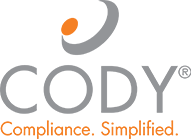Risk Management for Health Plans – Part 1
Recently, CODY® conducted, through our partnership with the Association for Community Affiliated Plans (ACAP), a webinar titled Identifying & Managing Risk. These are a few of the questions regarding risk management for health plans that we considered:
- How effective is your organization at identifying and managing risk within your health plan from an operational and compliance perspective?

- How evolved is your risk culture?
- What are the 5 pillars of Risk Management?
- What are the 5 questions to ask to identify risk?
- How do you calculate your risk score?
- How developed is your organization’s approach to risk management?
Listeners walked away with an in-depth understanding of how to improve risk culture through a prescriptive framework, what is needed from an operational approach to implement risk management practices, the life cycle of risk management for continuous processing, calculating risk scores, and emerging risks in healthcare.
Let’s first focus on risk culture.
Why is Risk Culture Important?
- It affects how everyone within the organization will perceive their own role and purpose and make better sense of the organization as a whole.
- It is a shared understanding held by a group of people, which helps bring uniformity to how people participate in risk management practices.
- It’s adaptive and will change over time, which can be a strength or a weakness for managing risk.
To evaluate an organization’s ability to effectively identify and manage risk, one must first be able to understand the organization’s Risk Culture. This is generally done by looking at a set of complex factors that influence and make up risk culture. The Institute of Risk Management narrowed those factors down to the effect one’s predisposition to risk can have on the organization, personal ethics that drive behavior and attitude, and organizational culture – overall respect towards risk. Risk culture is essentially the sum of these influencers that shape your value system from both a strategic and tactile decision-making position. An ideal risk culture would allow and reward for appropriate risk behavior while challenging inappropriate behavior- this generally occurs when the organization has a shared commitment to risk management practices, respect towards risk from senior management, transparency and timely reporting, and continuous monitoring and development.
Return next week for Part 2 of our Risk Management for Health Plans series where we will cover:
- A step-by-step guide to operationalize Risk Management.
Remember We’re Here to Help – CODY has led the industry for decades, and we have the expertise to help you manage your risk and maintain success. To learn more about our Risk Management products and services, contact us today for a consultation.
About us: Founded in 2006, CODY® is an Industry leader in Governance, Risk, and Compliance (GRC) Solutions designed exclusively for health plans. We enable over 70 government-funded, commercial, and ACA health plans across 50 states and Puerto Rico to mitigate compliance risk, maximize efficiencies, and improve outcomes. Our Enterprise technology and innovative solutions reduce administrative costs, increase accuracy, ensure regulatory compliance, and provide a better experience for plan members and providers.
